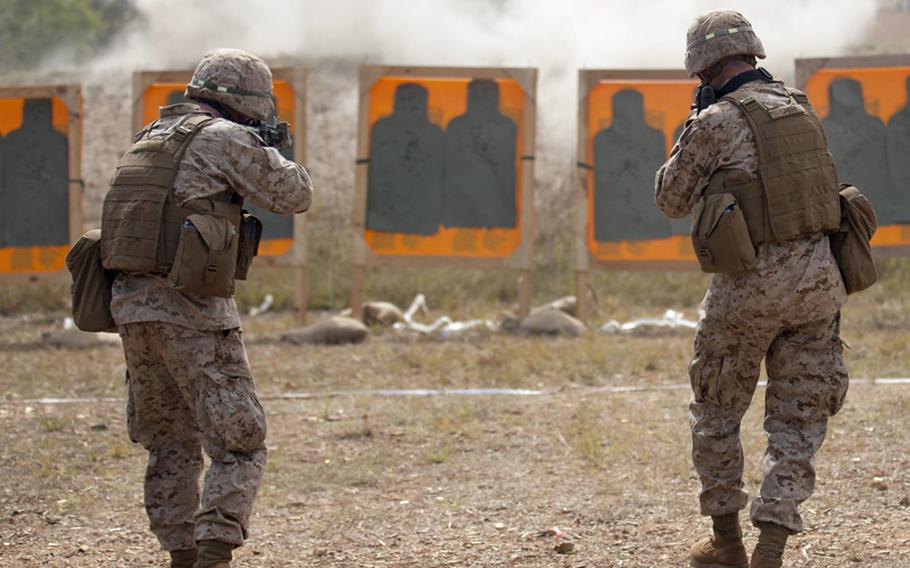
Marines with III Marine Expeditionary Force fire at a rifle target at Australia's Kangaroo Flats Training Area on April 18, 2012. ( Jacob D. Barber/U.S. Marine Corps)
CAMP FOSTER, Okinawa — After months of political wrangling, the U.S. and Japan on Friday unveiled a new accord on the layout of forces in the Pacific that aims to cut by half the controversial Marine Corps presence on Okinawa and redeploy about 9,000 Marines across the region.
But the new agreement has done nothing to change the deeply unpopular plan to relocate the Marine Corps’ Futenma air station on Okinawa, which has stalled the realignment effort for years and caused political turmoil in Japan.
In a joint statement Friday, Secretary of Defense Leon Panetta, Secretary of State Hillary Rodham Clinton and their Japanese counterparts called the current Futenma plan the “only viable option” and the two countries have agreed that it will now be handled separately from the rest of the realignment effort.
The realignment plan is an overhauled version of a 2006 U.S.-Japan accord that would have shifted about 8,600 Marines to the U.S. territory of Guam. It now calls for a military buildup of about 5,000 Marines on Guam, the redeployment of thousands of Marines to Hawaii, and the rotation of forces through Australia, according to a joint statement issued Friday.
If executed, the redeployment would be the most significant shift in U.S. forces here since World War II and a strategic rebalancing toward the Pacific after a decade of wars in the Middle East. But the plan must still survive the scrutiny of Congress, which has been pressing for cheaper alternatives to the basing plans and questioning the strategy behind the moves.
“Now that decisions have been made regarding the relocation of Marines to Guam, the Japanese government’s financial commitment, land returns south of Kadena, and the Futenma Replacement Facility and Marine Corps Air Station Futenma, we will work closely with our partners in the Japanese Self Defense Force to implement these decisions and to further improve this vital alliance of ours,” Secretary of Defense Leon Panetta said in a separately released statement.
Between 4,700 and 5,000 Marines will relocate from Okinawa to Guam, a U.S. defense official told reporters during a briefing on Thursday evening in Washington, according to The Associated Press.
The Guam buildup is now estimated to cost $8.6 billion and Japan has agreed to pay $3.1 billion of that cost, the official said. The total cost includes an unspecified amount for possible construction of new training ranges in the Northern Mariana Islands that could be used jointly by U.S. and Japanese forces, he said.
The previous Guam buildup plan could have cost the U.S. and Japan nearly $24 billion over a decade, the Government Accountability Office reported last year.
The two governments did not provide figures Friday on how many Marines would be deployed outside Guam, but recent media reports said about 2,700 Marines could be stationed in Hawaii and about 2,000 in Australia. It was not immediately clear whether all those servicemembers would come from Okinawa.
Meanwhile, Okinawa will continue to host some Marine Corps units, including III Marine Expeditionary Force Headquarters; 1st Marine Aircraft Wing Headquarters; 3rd Marine Logistics Group Headquarters; 31st Marine Expeditionary Unit; and base sustainment elements of Marine Corps Installations Pacific.
Japan has agreed to keep 10,000 Marines on Okinawa, where many local residents resent their presence and the noise and disruptions associated with their bases.
The Futenma base, located in the middle of a densely populated urban area, has long been a major irritant for Okinawans. The U.S. and Japan reiterated their intention to close the Futenma air station, as well as about five other American military facilities on Okinawa. The closures were also part of the stalled 2006 realignment agreement.
But the planned relocation of the Futenma base to Camp Schwab, a Marine base further north on the island, has generated fierce opposition from local residents, who fear the noise and damaging environmental impacts they believe would result. The prefecture’s governor has indicated he will not approve the necessary environmental permits that would allow the relocation to proceed.
U.S. officials, however, reiterated their insistence that the relocation of Futenma to Camp Schwab must go forward.
“We're still absolutely committed to the current plan,” a senior defense official, who declined to be identified, told reporters at the Pentagon. “We think it's the only viable plan that's been identified.”
Top lawmakers in the Senate Armed Services Committee have recently jumped into the fray and are attempting to force the consideration of alternative locations, such as the sprawling Kadena Air Base.
Sen. Carl Levin, D-Mich., chairman of the Armed Services Committee, Sen. John McCain, R-Ariz., and Sen. Jim Webb, D-Va., have proposed moving Futenma a few miles up the road to Kadena, the largest Air Force base in the Pacific. Meanwhile, they say some units at Kadena could be redeployed to other air bases in the region.
That alternative could break the stalemate over the Futenma relocation and lead to a net reduction in U.S. military air traffic on Okinawa, according to Webb.
“We still have many questions about the specific details of this statement and its implications for our force posture in the Asia-Pacific region,” the lawmakers said in a joint press release Friday.
Congress now holds the purse strings of the entire realignment plan and, at the urging of the Senate committee, has frozen any spending on it this year until the Department of Defense provides an independent study at the end of June that looks at other options for Futenma as well as the layout of the Air Force in the region.
Levin, McCain and Webb said no realignment plan will move forward without the approval of Congress.